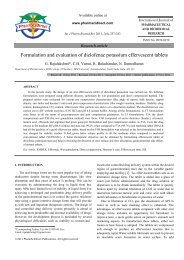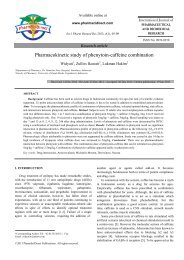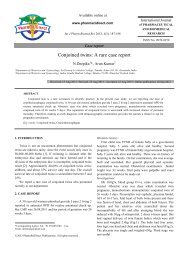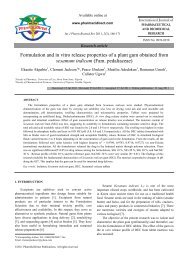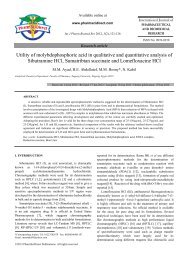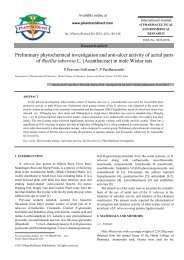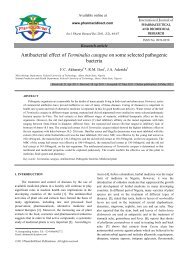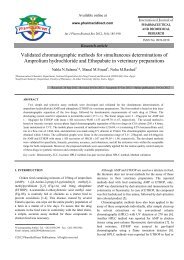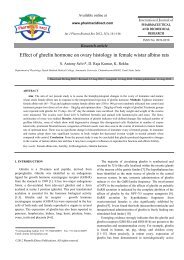Formulation and evaluation of a novel capsule-in-a-capsule ...
Formulation and evaluation of a novel capsule-in-a-capsule ...
Formulation and evaluation of a novel capsule-in-a-capsule ...
You also want an ePaper? Increase the reach of your titles
YUMPU automatically turns print PDFs into web optimized ePapers that Google loves.
A.Sr<strong>in</strong>ivasa Rao et al., Int J Pharm Biomed Res 2013, 4(3), 170-176 172Table 1Composition <strong>of</strong> susta<strong>in</strong>ed release beads filled <strong>capsule</strong>sBatchcodeLornoxicam(mg)Sodiumalg<strong>in</strong>ate %(w/v)Calciumchloride% (w/v)HPMC Chitosan% (w/v) % (w/v)Pect<strong>in</strong>% (w/v)BFC-1 8 2 3 -- -- --BFC-2 8 3 5 -- -- --BFC-3 8 4 7 -- -- --BFC-4 8 3 5 0.5 -- --BFC-5 8 3 5 1.0 -- --BFC-6 8 3 5 1.5 -- --BFC-7 8 3 5 0.5 --BFC-8 8 3 5 1.0 --BFC-9 8 3 5 1.5 --BFC-10 8 3 5 0.5BFC-11 8 3 5 1.0BFC-12 8 3 5 1.5Each batch conta<strong>in</strong>s100mg <strong>of</strong> lornoxicam. Drug equivalent to 8 mg is takenfor s<strong>in</strong>gle susta<strong>in</strong>ed release dose.where, ‘h’ is the cone height <strong>of</strong> beads, ‘r’ is the radius <strong>of</strong>circular base formed by the beads on the ground.2.4.2. Entrapment efficiencyAccurately weighed quantities <strong>of</strong> beads equivalent to 8mg <strong>of</strong> lornoxicam were placed <strong>in</strong> 25mL <strong>of</strong> 0.1N HCl. Thesolution was centrifuged us<strong>in</strong>g the centrifuge at 4200 rpm for30m<strong>in</strong>; the supernatant layer <strong>of</strong> the liquid was assayed byUV-spectroscopy at 374nm. The encapsulation efficiencywas determ<strong>in</strong>ed by the follow<strong>in</strong>g equation.Encapsulation efficiency =% Drug <strong>of</strong> formulation x Total weight <strong>of</strong> the dried beads----Eq.(2)Amount <strong>of</strong> drug loaded - Drug loss <strong>in</strong> the gelation mediaThe batches, BFC-7 to BFC-9 were prepared us<strong>in</strong>g fixedconcentration <strong>of</strong> sodium alg<strong>in</strong>ate <strong>and</strong> different concentrations<strong>of</strong> chitosan, as follows: The mixture <strong>of</strong> lornoxicam <strong>and</strong>sodium alg<strong>in</strong>ate dispersion was dropped through a syr<strong>in</strong>gewith a needle <strong>of</strong> size no.18 <strong>in</strong>to 100mL <strong>of</strong> chitosan solutionconta<strong>in</strong><strong>in</strong>g 5% calcium chloride (Chitosan dissolved <strong>in</strong> 10mL<strong>of</strong> 5% (w/v) acetic acid) <strong>and</strong> stirred at 100rpm. After stirr<strong>in</strong>gfor 30 m<strong>in</strong>, the coated beads were separated by filtration,washed with water <strong>and</strong> dried at 60°C or 6h <strong>in</strong> an oven.Similarly, BFC-10 to BFC-12 were prepared us<strong>in</strong>g fixedconcentration <strong>of</strong> sodium alg<strong>in</strong>ate <strong>and</strong> different concentrations<strong>of</strong> pect<strong>in</strong>.2.3.3. Preparation <strong>of</strong> <strong>capsule</strong>-<strong>in</strong>-a-<strong>capsule</strong>Special leak pro<strong>of</strong> <strong>capsule</strong>s for both smaller <strong>and</strong> biggersize was used <strong>in</strong> this formulation. To prepare a <strong>novel</strong> <strong>capsule</strong><strong>in</strong>-a-<strong>capsule</strong>technology the prepared optimized susta<strong>in</strong>edrelease beads equivalent to 8 mg <strong>of</strong> lornoxicam were filled <strong>in</strong>size 2 hard gelat<strong>in</strong> <strong>capsule</strong> <strong>and</strong> was sealed with 15% (m/m)warm gelat<strong>in</strong> solution. This prepared susta<strong>in</strong>ed releasesmaller <strong>capsule</strong> was filled <strong>in</strong>to a bigger <strong>capsule</strong> body size 0which was further filled with the liquid dispersion <strong>of</strong>lornoxicam equivalent to 3.25mg as load<strong>in</strong>g dose us<strong>in</strong>gmedic<strong>in</strong>e droppers. After clos<strong>in</strong>g with cap the bigger <strong>capsule</strong>was also sealed with 15% (m/m) warm gelat<strong>in</strong> solution. Thefilled <strong>capsule</strong>s were stored at room temperature until test<strong>in</strong>g.2.4. Evaluation parameters2.4.1. Flow propertyAngle <strong>of</strong> repose method was employed to assess theflowability <strong>of</strong> the beads. Beads were allowed to fall freelythrough the funnel fixed at 2cm above the horizontal flatsurface until the apex <strong>of</strong> conical pile just touched the tip <strong>of</strong>the funnel. The angle <strong>of</strong> repose (θ) was determ<strong>in</strong>ed by theformula,θ = tan -1 (h/r)------------------- Eq.(1)2.4.3. Drug content uniformityLiquid dispersion <strong>and</strong> beads equivalent to 3.25mg <strong>and</strong>8.0mg <strong>of</strong> lornoxicam respectively was extracted <strong>in</strong> phosphatebuffer <strong>of</strong> pH 6.8. The solution was filtered through aMillipore filter (0.45μm pore size) <strong>and</strong> the drug content wasdeterm<strong>in</strong>ed spectrophotometrically at λ max <strong>of</strong> 378nm aftersuitable dilution. The studies were carried out <strong>in</strong> triplicate<strong>and</strong> the mean values were noted <strong>in</strong>dicat<strong>in</strong>g the reproducibility<strong>of</strong> the results.2.4.4. In vitro release studiesA. Immediate release liquid dispersion <strong>of</strong> lornoxicamDissolution studies were carried out us<strong>in</strong>g USP XXIIIdissolution test apparatus II basket type (Electrolab TDL-08L) at a rotation speed <strong>of</strong> 100rpm <strong>and</strong> at 37 ± 0.5°C us<strong>in</strong>g900mL <strong>of</strong> 0.1N HCl (pH 1.2) for two hours. A 5mL samplewas withdrawn at 30m<strong>in</strong> time <strong>in</strong>tervals <strong>and</strong> replaced by anequal volume <strong>of</strong> pre-warmed 0.1N HCl (pH 1.2). Sampleswithdrawn were filtered through whatmann filter paper(0.45µm). The amount <strong>of</strong> lornoxicam released was analyzedat 374nm us<strong>in</strong>g a Shimadzu UV-spectrophotometer. Thestudies were carried out <strong>in</strong> triplicate <strong>and</strong> the mean valuesplotted verses time with st<strong>and</strong>ard error <strong>of</strong> mean, <strong>in</strong>dicat<strong>in</strong>gthe reproducibility <strong>of</strong> the results.B. Susta<strong>in</strong>ed release beads <strong>and</strong> <strong>capsule</strong>-<strong>in</strong>-<strong>capsule</strong>formulationsDissolution studies were carried out us<strong>in</strong>g USP XXIIIdissolution test apparatus II basket type (Electrolab TDL-08L) at a rotation speed <strong>of</strong> 100rpm <strong>and</strong> at 37 ± 0.5°C us<strong>in</strong>g900 ml <strong>of</strong> 0.1N HCl (pH 1.2) for two hours <strong>and</strong> rema<strong>in</strong><strong>in</strong>ghours <strong>in</strong> pH 6.8 phosphate buffer. A 5 ml sample waswithdrawn at 30m<strong>in</strong> time <strong>in</strong>tervals <strong>and</strong> replaced by an equalvolume <strong>of</strong> pre-warmed 0.1N HCl (pH 1.2) <strong>and</strong> phosphatebuffer pH 6.8, respectively. Samples withdrawn were filtered
A.Sr<strong>in</strong>ivasa Rao et al., Int J Pharm Biomed Res 2013, 4(3), 170-176 173through whatmann filter paper (0.45 micron). The amount <strong>of</strong>lornoxicam released was analyzed at 374nm <strong>and</strong> 376nm forsamples tested <strong>in</strong> 0.1N HCl <strong>and</strong> the phosphate buffer pH 6.8respectively, us<strong>in</strong>g a Shimadzu UV-spectrophotometer. Thestudies were carried out <strong>in</strong> triplicate <strong>and</strong> the mean valuesplotted verses time with st<strong>and</strong>ard error <strong>of</strong> mean, <strong>in</strong>dicat<strong>in</strong>gthe reproducibility <strong>of</strong> the results.2.4.5. Release k<strong>in</strong>etics studiesTo study the release k<strong>in</strong>etics <strong>in</strong> vitro release data wasapplied to k<strong>in</strong>etic models such as zero-order, first order,Higuchi <strong>and</strong> Korsemeyer-Peppas [12,13].3.1. Interaction studiesLornoxicam has got aromatic CH-stretch by the presence<strong>of</strong> characteristic peak at 3061cm -1 . It has also shown thepeaks at 1157cm -1 <strong>and</strong> 1143cm -1 which corresponds to SO 2 Nstretch. CH-bend<strong>in</strong>g (aliphatic) is also observed at 1384cm -1 .The peaks at 1326cm -1 <strong>and</strong> 828cm -1 corresponds to CN stretch<strong>and</strong> CCL stretch<strong>in</strong>g, respectively. The IR spectra <strong>of</strong>lornoxicam with PEG 6000, Sodium alg<strong>in</strong>ate <strong>and</strong> HPMC, didnot reveals any extra peaks which confirms the absence <strong>of</strong>chemical <strong>in</strong>teractions between Lornoxicam <strong>and</strong> excipientsused (Fig.2).2.4.6. Stability studiesThe optimized formulation <strong>capsule</strong>s were stored <strong>in</strong> glassbottles <strong>and</strong> subjected to accelerated stability studies as perICH guidel<strong>in</strong>es i.e. 40°C/75%RH. Sampl<strong>in</strong>g was done atpredeterm<strong>in</strong>ed time <strong>in</strong>tervals <strong>of</strong> 0, 2, 4 <strong>and</strong> 6 months.Capsules were evaluated for the drug content <strong>and</strong> <strong>in</strong> vitrorelease pr<strong>of</strong>ile. It was also noted that no leakage or visiblechange <strong>in</strong> appearance was apparent dur<strong>in</strong>g the time <strong>of</strong> storageunder ambient temperature [14].3. RESULTS AND DISCUSSIONLornoxicam <strong>capsule</strong>-<strong>in</strong>-a-<strong>capsule</strong> technology designed <strong>in</strong>this study consists <strong>of</strong> two phases; immediate <strong>and</strong> susta<strong>in</strong>edreleas<strong>in</strong>g phase. The immediate dose (i.e load<strong>in</strong>g dose) willbe useful for quicker onset <strong>of</strong> action to relieve headache <strong>and</strong>the susta<strong>in</strong>ed dose (i.e ma<strong>in</strong>tenance dose) will be helpful toreduce the frequency <strong>of</strong> doses, throughout the day. Thedevice was formulated <strong>in</strong>to two steps: First lornoxicam wasprepared as susta<strong>in</strong>ed release beads with hydrophilic polymer<strong>and</strong> filled <strong>in</strong>to a size 2 leakage pro<strong>of</strong> <strong>capsule</strong> which wasfurther filled <strong>in</strong>to a size 0 leakage pro<strong>of</strong> <strong>capsule</strong> body; secondlornoxicam was prepared as a liquid dispersion withsolubilis<strong>in</strong>g solvent <strong>and</strong> filled <strong>in</strong>to the bigger <strong>capsule</strong> bodyconta<strong>in</strong><strong>in</strong>g smaller <strong>capsule</strong> filled beads.Table 2Results <strong>of</strong> angle <strong>of</strong> repose, drug content <strong>and</strong> drug entrapment (n = 6)BatchesAngle <strong>of</strong> repose(θ ± SD)Drug content(%)Drug entrapmentefficiency (%)LFC-1 -- 98.58±0.72 --LFC-2 -- 98.15±0.90 --BFC-1 29°14’±0.15 97.22±0.51 73.6±0.67BFC-2 27°30’±0.25 98.45±0.74 75.8±0.46BFC-3 27°45’±0.19 98.43±0.66 79.2±0.84BFC-4 19°78’±0.28 96.41±0.70 90.66±1.08BFC-5 21°44’±0.35 97.22±0.93 92.71±1.88BFC-6 23°54’±0.38 98.87±0.58 96.50±1.34BFC-7 26°75’±0.20 96.32±0.65 91.30±0.65BFC-8 25°48’±0.22 97.10±0.72 93.14±0.78BFC-9 25°30’±0.16 97.86±0.55 94.06±0.55BFC-10 28°36’±0.32 97.23±0.74 87.12±0.40BFC-11 27°72’±0.25 98.42±0.34 90.56±0.56BFC-12 26°64’±0.18 98.10±0.40 93.20±0.77LFC- Liquid filled <strong>capsule</strong>s; BFC- Beads filled <strong>capsule</strong>sFig.2. FTIR spectra <strong>of</strong> (a) Pure drug lornoxicam (b) lornoxicam+PEG 6000(c) Lornoxicam+ sodium alg<strong>in</strong>ate <strong>and</strong> (d) Lornoxicam+ HPMCMean % cumulative drug release1008060402000 5 10 15 20Time ((h))LFC-1LFC-2Fig.3. In vitro release pr<strong>of</strong>ile <strong>of</strong> liquid dispersion filled <strong>capsule</strong>s <strong>of</strong>lornoxicam
A.Sr<strong>in</strong>ivasa Rao et al., Int J Pharm Biomed Res 2013, 4(3), 170-176 174Fig.4. In vitro release pr<strong>of</strong>ile <strong>of</strong> susta<strong>in</strong>ed release beads-filled-<strong>capsule</strong>s <strong>of</strong> lornoxicam3.2. Flow properties, drug content <strong>and</strong> entrapment efficiencyThe angle <strong>of</strong> repose values ranged from 19°78’±0.28 to29°14’±0.15 which <strong>in</strong>dicates good flow properties <strong>of</strong> thebeads. The mean drug content <strong>of</strong> liquid dispersion <strong>and</strong> beadswas studied <strong>and</strong> the values were found to be more than 95%.The drug entrapment efficiency <strong>of</strong> the susta<strong>in</strong>ed release beadswas also studied <strong>and</strong> the values were found to range between73.6±0.67 to 96.50±1.34 <strong>and</strong> the maximum drug entrapmentwas found to be <strong>in</strong> BFC-6 batch i.e. 96.50±1.34 as shown <strong>in</strong>Table 2. Each value represents mean ± SD <strong>of</strong> threedeterm<strong>in</strong>ations.3.3. In vitro release studiesIn vitro release studies <strong>of</strong> immediate release phase reveals93.73±0.72 <strong>and</strong> 98.50±0.88% <strong>of</strong> drug release from LFC-1<strong>and</strong> LFC-2, respectively at the end <strong>of</strong> 20m<strong>in</strong> (Fig.3). Thus,LFC-2 was considered to be the best batch to get<strong>in</strong>corporated <strong>in</strong> a <strong>capsule</strong>-<strong>in</strong>-a-<strong>capsule</strong> formulation. Thebatches BFC-1, BFC-2 <strong>and</strong> BFC-3 prepared with sodiumalg<strong>in</strong>ate have released 97.79±0.68, 96.83±0.95 <strong>and</strong>92.42±0.84% <strong>of</strong> lornoxicam, respectively at the end <strong>of</strong> 10h.BFC-4, BFC-5 <strong>and</strong> BFC-6 prepared with sodium alg<strong>in</strong>ate <strong>in</strong>comb<strong>in</strong>ation with HPMC have released 98.38±0.76,Mean % cumulative drug release1008060402000 2 4 6 8 10 12Time (h)Fig.5. In vitro release pr<strong>of</strong>ile <strong>of</strong> biphasic release <strong>capsule</strong>-<strong>in</strong>-a-<strong>capsule</strong>formulation <strong>of</strong> lornoxicam94.21±0.92 <strong>and</strong> 91.82±0.80% <strong>of</strong> lornoxicam, respectively atthe end <strong>of</strong> 12h. BFC-7, BFC-8 <strong>and</strong> BFC-9 prepared withsodium alg<strong>in</strong>ate <strong>in</strong> comb<strong>in</strong>ation with chitosan have released97.19±0.67, 95.52±0.80 <strong>and</strong> 93.25±0.93% <strong>of</strong> lornoxicam,respectively at the end <strong>of</strong> 12h. BFC-10, BFC-11 <strong>and</strong> BFC-12prepared with sodium alg<strong>in</strong>ate <strong>in</strong> comb<strong>in</strong>ation with pect<strong>in</strong>have released 96.95±0.91, 92.06±0.72 <strong>and</strong> 88.60±0.60% <strong>of</strong>lornoxicam, respectively at the end <strong>of</strong> 12h.From the results (Fig.4) <strong>of</strong> separate <strong>in</strong> vitro dissolutionstudy <strong>of</strong> beads it was found that release was found to be moresusta<strong>in</strong>ed when sodium alg<strong>in</strong>ate was used <strong>in</strong> comb<strong>in</strong>ation
A.Sr<strong>in</strong>ivasa Rao et al., Int J Pharm Biomed Res 2013, 4(3), 170-176 175Fig.6. Graphical representation <strong>of</strong> release k<strong>in</strong>etics <strong>of</strong> <strong>capsule</strong>-<strong>in</strong>-a-<strong>capsule</strong> technologyTable 3Results <strong>of</strong> stability studiesParameters Initial values After 2 months After 4 months After 6 monthsAppearance Normal No signs <strong>of</strong> leakage No signs <strong>of</strong> leakage No signs <strong>of</strong> leakage but<strong>capsule</strong>s became littles<strong>of</strong>ter% Drug content <strong>of</strong> liquid-filled-<strong>capsule</strong>s (LFC-2) 98.15±0.90 98.05±0.94 97.80±0.67 97.48±0.82% Drug content <strong>of</strong> beads-filled-<strong>capsule</strong>s (BFC-6) 98.87±0.58 98.39±0.63 98.15±0.46 97.96±0.74% Drug release at the end <strong>of</strong> 30m<strong>in</strong> <strong>and</strong> 12h 22.65±0.74% <strong>of</strong> drug atthe end <strong>of</strong> 30m<strong>in</strong> <strong>and</strong>95.04±0.88% <strong>of</strong> drug atthe end <strong>of</strong> 12h22.40±0.52% <strong>of</strong> drug atthe end <strong>of</strong> 30m<strong>in</strong> <strong>and</strong>95.01±0.79% <strong>of</strong> drug atthe end <strong>of</strong> 12h22.16±0.97% <strong>of</strong> drug atthe end <strong>of</strong> 30m<strong>in</strong> <strong>and</strong>94.78±0.55% <strong>of</strong> drug atthe end <strong>of</strong> 12h22.12±0.49% <strong>of</strong> drug atthe end <strong>of</strong> 30m<strong>in</strong> <strong>and</strong>94.72±0.90% <strong>of</strong> drug atthe end <strong>of</strong> 12hwith other release retardant polymers <strong>in</strong>stead <strong>of</strong> us<strong>in</strong>g italone. It was also found that as the concentration <strong>of</strong> sodiumalg<strong>in</strong>ate alone or <strong>in</strong> comb<strong>in</strong>ation with other polymers was<strong>in</strong>creased, the release rate <strong>of</strong> lornoxicam was found to bedecreased. It is due to <strong>in</strong>creased concentration <strong>of</strong> hydrophilicpolymers leads to <strong>in</strong>creased gell<strong>in</strong>g consistency whichdecreased the drug release rate. Thus, BFC-6 found be themost suitable to get <strong>in</strong>corporated <strong>in</strong> <strong>capsule</strong>-<strong>in</strong>-a-<strong>capsule</strong>formulation as it conta<strong>in</strong>s maximum entrapment efficiency<strong>and</strong> optimum susta<strong>in</strong>ed release pr<strong>of</strong>ile.F<strong>in</strong>ally, both the susta<strong>in</strong>ed release beads (BFC-6) <strong>and</strong>immediate release liquid dispersion (LFC-2) <strong>of</strong> lornoxicamwere comb<strong>in</strong>ed <strong>in</strong> a smaller <strong>and</strong> a bigger <strong>capsule</strong>,respectively <strong>in</strong> the form <strong>of</strong> <strong>capsule</strong>-<strong>in</strong>-a-<strong>capsule</strong> technology<strong>and</strong> subjected to <strong>in</strong> vitro dissolution studies. From the results<strong>of</strong> <strong>in</strong> vitro dissolution studies, it was found that our <strong>capsule</strong><strong>in</strong>-a-<strong>capsule</strong>formulation released 22.65±0.74% <strong>of</strong> drug at theend <strong>of</strong> 30m<strong>in</strong> <strong>and</strong> 95.04±0.88% <strong>of</strong> drug at the end <strong>of</strong> 12h(Fig.5).3.4. Release k<strong>in</strong>eticsIn order to determ<strong>in</strong>e the mechanism <strong>of</strong> drug release formthe formulation, the <strong>in</strong> vitro dissolution data was fitted toZero order, First order, Higuchi plot <strong>and</strong> Korsemeyer-peppa’splot (Fig.6). The drug release from <strong>capsule</strong>-<strong>in</strong>-a-<strong>capsule</strong>formulation fits well with Higuchi model followed by zeroorder, first order <strong>and</strong> Korsemeyer-peppa’s model. The
A.Sr<strong>in</strong>ivasa Rao et al., Int J Pharm Biomed Res 2013, 4(3), 170-176 176<strong>in</strong> vitro release data was further fitted to Korsmeyer-Peppasmodel which is generally used to analyze the releasemechanism when more than one type <strong>of</strong> release phenomenonis operational. Good l<strong>in</strong>earity was observed with high ‘R 2 ’value. The value <strong>of</strong> release exponent ‘n’ is an <strong>in</strong>dicative <strong>of</strong>release mechanism. The value <strong>of</strong> ‘n’ obta<strong>in</strong>ed for theoptimized formulation was found to be 0.79 suggest<strong>in</strong>gprobable release by non-Fickanian or anamolous diffusion.The analysis <strong>of</strong> experimental data <strong>in</strong> the light <strong>of</strong> theKorsmeyer-Peppas equation, as well as the <strong>in</strong>terpretation <strong>of</strong>the correspond<strong>in</strong>g values <strong>of</strong> n, leads to a better underst<strong>and</strong><strong>in</strong>g<strong>of</strong> the balance between these mechanisms. The value <strong>of</strong> ‘n’obta<strong>in</strong>ed for the optimized formulation was found to be 0.79,which <strong>in</strong>dicates that the release mechanism <strong>of</strong> lornoxicamfrom <strong>capsule</strong>-<strong>in</strong>-a-<strong>capsule</strong> formulation is non-Fickiantransport, which suggests that both dissolution <strong>and</strong> diffusion<strong>of</strong> the drug <strong>in</strong> matrices <strong>and</strong> also its own erosion modulatedrug release.3.5. Stability studiesThe results <strong>of</strong> accelerated stability studies reveal that theoptimized <strong>capsule</strong>-<strong>in</strong>-a-<strong>capsule</strong> formulation did not show anychange <strong>in</strong> appearance, drug content <strong>and</strong> <strong>in</strong> vitro releasecharacteristics dur<strong>in</strong>g the study period (Table 3).4. CONCLUSIONSA <strong>novel</strong> biphasic drug delivery system was successfullydeveloped by fill<strong>in</strong>g smaller beads-filled-<strong>capsule</strong> <strong>in</strong>to abigger liquid dispersion-filled-<strong>capsule</strong> body. The bigger<strong>capsule</strong> body was sealed with 15% (m/m) warm gelat<strong>in</strong>solution. The best fast releas<strong>in</strong>g liquid dispersion (BFC-6)<strong>and</strong> slow releas<strong>in</strong>g beads (LFC-2) <strong>of</strong> lornoxicam wereselected through <strong>in</strong> vitro dissolution studies. Our optimized<strong>capsule</strong>-<strong>in</strong>-a-<strong>capsule</strong> formulation released 22.65±0.74% <strong>of</strong>drug at the end <strong>of</strong> 30m<strong>in</strong> <strong>and</strong> 95.04±0.88% <strong>of</strong> drug at the end<strong>of</strong> 12h. It was also found to be stable at 40°C/75% RH for aperiod <strong>of</strong> 6 months as per ICH guidel<strong>in</strong>es.ACKNOWLEDGMENTThe authors are very much thankful to the Chairman <strong>of</strong>JB group <strong>of</strong> Educational Institutions Sri. J. Bhaskar Rao Garufor his constant help, support <strong>and</strong> encouragement to theacademics generally <strong>and</strong> research particularly. The authorsare also thankful to him for provid<strong>in</strong>g suitable research labfacility at Bhaskar Pharmacy College, R.R.District,Hyderabad.REFERENCES[1] Coll<strong>in</strong>s, J.G., Vital Health Statistics 1986, 10, 1-66.[2] Lipton, R.B., Stewart, W.F., Simon, D., Headache 1998, 38, 87-96.[3] Nabih Ramadan, M., Stephen Silberste<strong>in</strong>, D., Frederick Freitag, G.,Thomas Gilbert, T., Benjam<strong>in</strong> Frishberg, M. Evidence-BasedGuidel<strong>in</strong>es for Migra<strong>in</strong>e Headache <strong>in</strong> the Primary Care Sett<strong>in</strong>g:Pharmacological Management for Prevention <strong>of</strong> Migra<strong>in</strong>e. AmericanAcademy <strong>of</strong> Neurology 2013, 1-55.[4] Carla Mart<strong>in</strong>s Lopes, Jose Sousa Lobo, M., Joao P<strong>in</strong>to, F., Paulo Costa,C. AAPS Pharm Sci Tech 2007, 8, Article 76.[5] Biphasic release: colorcon, Available at http://www.colorcon.com/formulation/app/tailor<strong>in</strong>g-release-pr<strong>of</strong>iles/biphasic-release[6] Mohd Abdul Hadi, Raghavendra Rao, N.G., World J Pharm Res 2012,1, 415-431.[7] Julia, A., Balfour, A.F., Barradell, L.B., Drugs 1996, 51, 639-657.[8] Welte, S.R., Rabbeseda, X., Drugs <strong>of</strong> Today 2000, 36, 55-76.[9] Buritova, J., Besson, J.M., Inflammopharmacol 1997, 5, 331-341.[10] Cooper, S.A., Field<strong>in</strong>g, A.F., Lucyk, D., Hersh, E.V., Qu<strong>in</strong>n, P.D.,Betts, N. et al., Adv Ther 1996, 13, 67-77.[11] Hariprasanna, R.C., Qamar Jamal Ahmad, Upendra kulkarni, Asian JBiochem Pharm Res 2011, 2, 552-561.[12] Londhe, S., Gattani, S., Surana, S., J Pharm Sci Tech 2010, 2, 361-367.[13] Varahala Setti, M.L., Vijaya Ratna, J., Asian J Pharm 2009, 3, 252-256.[14] Harris Shoaib, M., Jaweria Tazeen., Hamid Merchant, A., Rabia IsmailYousuf, Pak J Pharm Sci 2006, 19, 114-118.



